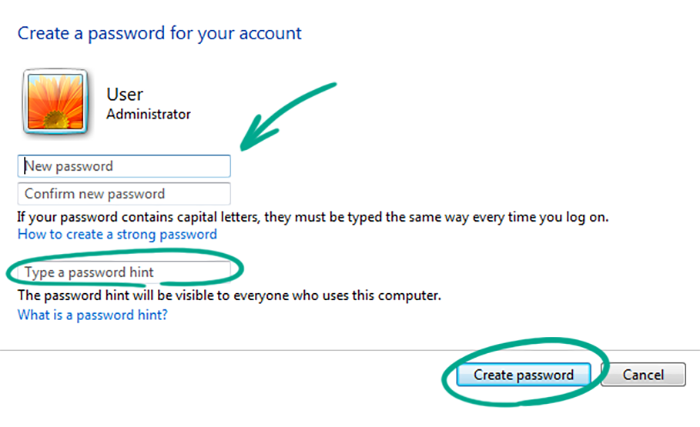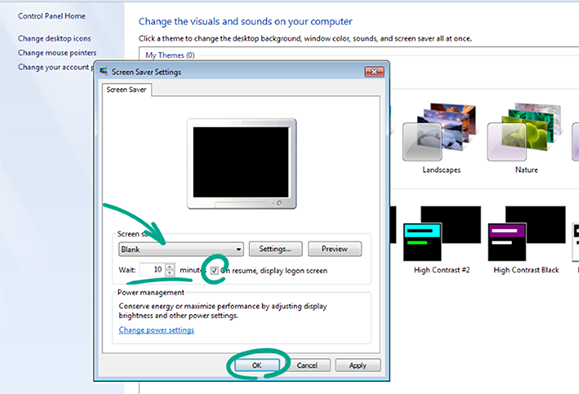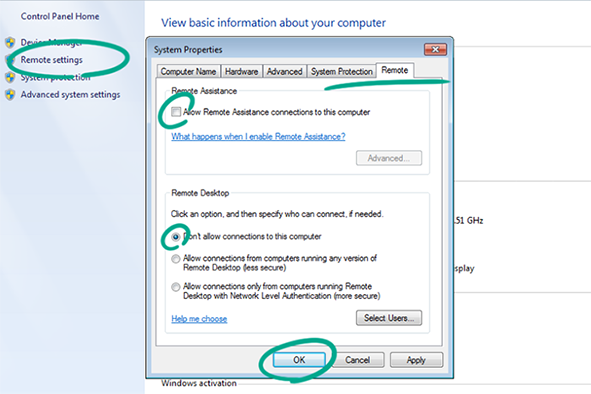Windows 7 end of support
open allMicrosoft has ended support for Windows 7. As of January 14, 2020, updates for the OS, including vulnerability fixes, are no longer available. This lack of support greatly reduces your security. We recommend switching to Windows 11, which is still receiving updates. If for any reason you cannot do that, you should never turn off system protection for any reason, and you must also use a reliable security solution.
How to protect your account
open allWhat for: To keep your account from being hacked.
Windows 7 lets you set a password to log in to the system (or more accurately, to your account on it). If you do not set a password for your account, other people (relatives, visiting acquaintances, plumbers, etc.) will be able to use the computer in your name in your absence. In the best-case scenario, the unauthorized user may change your desktop wallpaper to something funny. However, they can instead opt to infect your device with malware, copy private information, or corrupt files you need.
If you use a short and simple password, then strangers will be able to guess it easily. The more complicated and longer your secret password combination, the harder it will be for someone to hack your computer. Use a strong password that:
- Consists of 8–20 characters.
- Contains lowercase and uppercase letters, numbers, and special characters ($, @).
- Is not an actual word or known phrase.
- Is not the same as your password for any other of your social network accounts.
- Does not contain information that strangers could easily find out (your name or the name of a loved one, pet’s name, date of birth).
To change your password or create a new one:
- Press the Start menu button in the bottom left corner of the screen and select Control Panel in the right column of the menu.
- If you have configured the sections of the Control Panel to be displayed by category, open the User Accounts and Family Safety section and click User Accounts. If the items in the Control Panel appear as a list, select User Accounts.
- Select Change your password. If no password has already been set, select Create a password for your account.
- In the window that opens, enter the current password for your account and enter the new password twice. If you are creating a password for the first time, you will only need to enter the new password twice.

- If necessary, enter a password hint (a word or phrase to display if you forget your password) that will help you remember your password. Do not enter the password combination itself as the hint.
- Click Change password.
What for: To prevent anyone from getting access to your computer in your absence.
If an attacker obtains physical access to your computer when you are away from it, they can steal important information from it or install malware on it. To avoid that, set a screen lock that will turn on if you step away from Windows for a while. If you have set a password for your account, strangers will not be able to disable the lock without it.
To set a screen lock:
- Press the Start menu button in the bottom left corner of the screen and select Control Panel in the right column of the menu.
- If you have configured the sections of the Control Panel to be displayed by category, open Appearance and Personalization and click Personalization. If the items in the Control Panel appear as a list, select Personalization.
- In the window that opens, click Screen Saver.
- In the screen saver settings window:
- Tick the check box next to the On resume, display logon screen item.
- Enter the amount of time without activity on the computer before it should activate the screen lock, such as, for example, 10 minutes.
- Optionally, select a screen saver from the drop-down menu.
- Click OK.

How to keep strangers out
open allWhat for: To prevent attackers from taking control of your system.
Remote connections allow you to view and manage data on your computer remotely. This can be useful if you are connecting to your work device from home or you are contacting technical support to resolve a problem with the operating system or your apps. At the same time, remote access may be used by attackers to steal your information, install malware and take control of your device.
We recommend that you disable the ability to remotely connect to your computer and activate it only if necessary for a limited period of time. To block remote connections:
- Press the Start menu button in the bottom left corner of the screen and select Control Panel in the right column of the menu.
- If you have configured the sections of the Control Panel to be displayed by category, open the System and Security section and the System subsection. If the items in the Control Panel appear as a list, select the System item.
- Select Remote settings in the menu at the left.
- If Windows asks you to confirm the operation, select Yes.
- In the System Properties window that opens, on the Remote tab:
- Untick the check box next to the Allow Remote Assistance connections to this computer item in the Remote Assistance section.
- Tick the check box next to the Don’t allow remote connections to this computer item in the Remote Desktop section. You may not see this section because some versions of Windows do not support this connection.
- Click OK.





